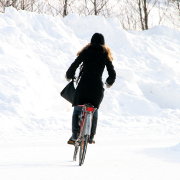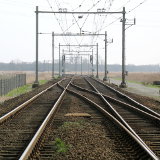 The towns of Utrecht and Zutphen will start experiments with heating bike paths, DutchNews reports.
The towns of Utrecht and Zutphen will start experiments with heating bike paths, DutchNews reports.
The news site quotes a Telegraaf article that says these experiments will start ‘soon’. The idea is that ‘asphalt collectors’ will collect and store the summer heat, and release this energy in the winter to stop ice from forming. This could reduce accidents:
‘The result is cooler asphalt in summer and a warmer surface in winter,’ Marcel Boerefijn, the project’s leader, is quoted as saying. In the future, footpaths could also be kept ice-free using the same techniques, he said.
Boerefijn says the new surface and heat collection system will cost between €30,000 and €40,000 a kilometre – about the same as it costs to lay new asphalt.
Car drivers need not feel left out. In 2013 a “few hundred metres of glow in the dark, weather-indicating road will be installed in the province of Brabant” according to Wired.
The special paint needed for these glow in the dark roads was developed by Studio Roosegaarde and will be used to create road markings.
The studio has also been working on a paint that will be invisible until the temperature drops below a certain point. This could be used according to designer Daan Roosegaarde to indicate that the road is slippery.
The idea is to not only use more sustainable methods of illuminating major roads, thus making them safer and more efficient, but to rethink the design of highways at the same time as we continue to rethink vehicle design. As Studio Roosegaarde sees it, connected cars and internal navigation systems linked up to the traffic news represent just one half of our future road management systems — roads need to fill their end of the bargain and become intelligent, useful drivers of information too.
See also: A Dutch bike path with solar panels
(Photo by Flickr user comedynose, some rights reserved)
 ProRail is planning to use lasers to burn off the leafy mulch that coats rails in the autumn, Z24 reports.
ProRail is planning to use lasers to burn off the leafy mulch that coats rails in the autumn, Z24 reports. 
 The towns of Utrecht and Zutphen will start experiments with heating bike paths,
The towns of Utrecht and Zutphen will start experiments with heating bike paths,